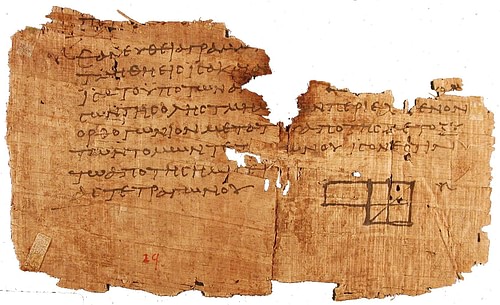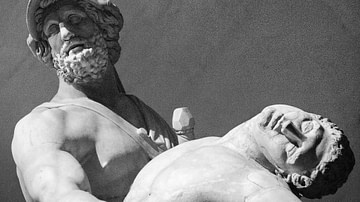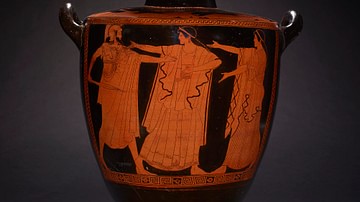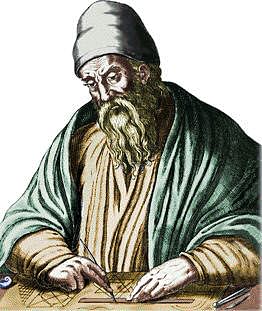
Euclid of Alexandria (lived c. 300 BCE) systematized ancient Greek and Near Eastern mathematics and geometry. He wrote The Elements, the most widely used mathematics and geometry textbook in history. Older books sometimes confuse him with Euclid of Megara. Modern economics has been called "a series of footnotes to Adam Smith," who was the author of The Wealth of Nations (1776 CE). Likewise, much of Western mathematics has been a series of footnotes to Euclid, either developing his ideas or challenging them.
EUCLID'S LIFE
Almost nothing is known of Euclid's life. Around 300 BCE, he ran his own school in Alexandria, Egypt. We do not know the years or places of his birth and death. He seems to have written a dozen or so books, most of which are now lost.
The philosopher Proclus of Athens (412-485 CE), who lived seven centuries later, said that Euclid "put together the Elements, collecting many of Eudoxus's theorems, perfecting many of Theaetetus's, and bringing to irrefragable demonstration things which were only somewhat loosely proved by his predecessors." The scholar Stobaeus lived at about the same time as Proclus. He collected Greek manuscripts that were in danger of being lost. He told a story about Euclid that has the ring of truth:
Someone who had begun to [study] geometry asked Euclid, 'What shall I get by learning these things?' Euclid called his slave and said, 'Give him [some money], since he must make gain out of what he learns'.
(Heath, 1981, loc. 8625)
GEOMETRY BEFORE EUCLID
In The Elements, Euclid collected, organized, and proved geometric ideas that were already used as applied techniques. Except for Euclid and some of his Greek predecessors such as Thales (624-548 BCE), Hippocrates (470-410 BCE), Theaetetus (417-369 BCE), and Eudoxus (408-355 BCE), hardly anyone had tried to figure out why the ideas were true or if they applied in general. Thales even became a celebrity in Egypt because he could see the mathematical principles behind rules for specific problems, then apply the principles to other problems such as determining the height of the pyramids.
The ancient Egyptians knew a lot of geometry, but only as applied methods based on testing and experience. For example, to calculate the area of a circle, they made a square whose sides were eight-ninths the length of the circle's diameter. The area of the square was close enough to the area of the circle that they could not detect any difference. Their method implies that pi has a value of 3.16, slightly off its true value of 3.14... but close enough for simple engineering. Most of what we know about ancient Egyptian mathematics comes from the Rhind Papyrus, discovered in the mid-19th century CE and now kept in the British Museum.
Ancient Babylonians also knew a lot of applied mathematics, including the Pythagorean theorem. Archaeological excavations at Nineveh discovered clay tablets with number triplets satisfying the Pythagorean theorem, such as 3-4-5, 5-12-13, and with considerably larger numbers. As of 2006 CE, 960 of the tablets had been deciphered.
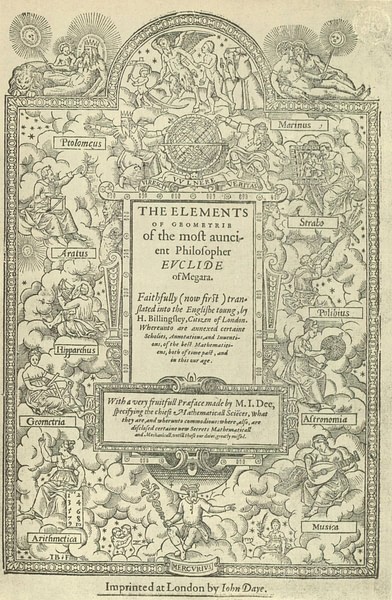
THE ELEMENTS
Euclid did not originate most of the ideas in The Elements. His contribution was fourfold:
- He collected important mathematical and geometric knowledge in one book. The Elements is a textbook rather than a reference book, so it does not cover everything that was known.
- He gave definitions, postulates, and axioms. He called axioms "common notions."
- He presented geometry as an axiomatic system: Every statement was either an axiom, a postulate, or was proven by clear logical steps from axioms and postulates.
- He gave some of his own original discoveries, such as the first known proof that there are infinitely many prime numbers.
The Elements has 13 chapters (often called "books"), divided into three main sections:
Chapters 1-6: Plane geometry.
Chapters 7-10: Arithmetic and number theory.
Chapters 11-13: Solid geometry.
Every chapter begins with definitions. Chapter 1 also includes postulates and "common notions" (axioms). Examples are:
Definition: "A point is that which has no part."
Postulate: "To draw a straight line from any point to any point." (That's Euclid's way of saying straight lines exist.)
Common Notion: "Things equal to the same thing are also equal to each other."
If the ideas seem obvious, that's the point. Euclid wanted to base his geometry on ideas so obvious that no one could reasonably doubt them. From his definitions, postulates, and common notions, Euclid deduces the rest of geometry. His geometry describes the normal space we see around us. Modern 'non-Euclidean' geometries describe space over astronomical distances, at near-light speeds, or warped by gravity.
EUCLID'S OTHER WORKS
About half of Euclid's works are lost. We only know about them because other ancient writers refer to them. Lost works include books on conic sections, logical fallacies, and "porisms." We're not sure what porisms were. Euclid's works that still exist are The Elements, Data, Division of Figures, Phenomena, and Optics. In his book about optics, Euclid argued for the same theory of vision as the Christian philosopher St. Augustine.
EUCLID'S INFLUENCE
From ancient times to the late 19th century CE, people considered The Elements as a perfect example of correct reasoning. More than a thousand editions have been published, making it one of the most popular books after theBible. The 17th-century CE Dutch philosopher Baruch de Spinoza modeled his book Ethics on The Elements, using the same format of definitions, postulates, axioms, and proofs. In the 20th century, the Austrian economist Ludwig von Mises adopted Euclid's axiomatic method to write about economics in his book Human Action.
